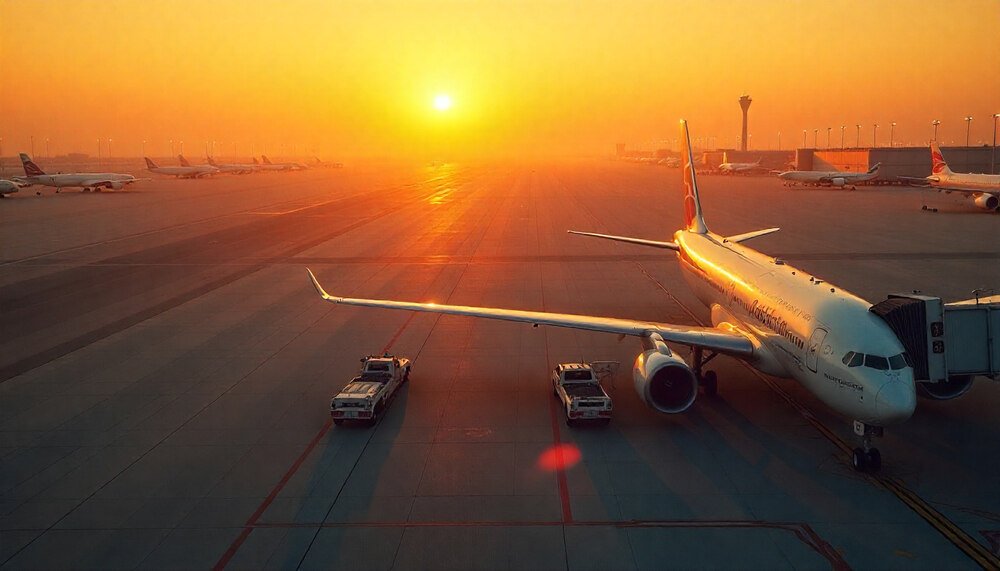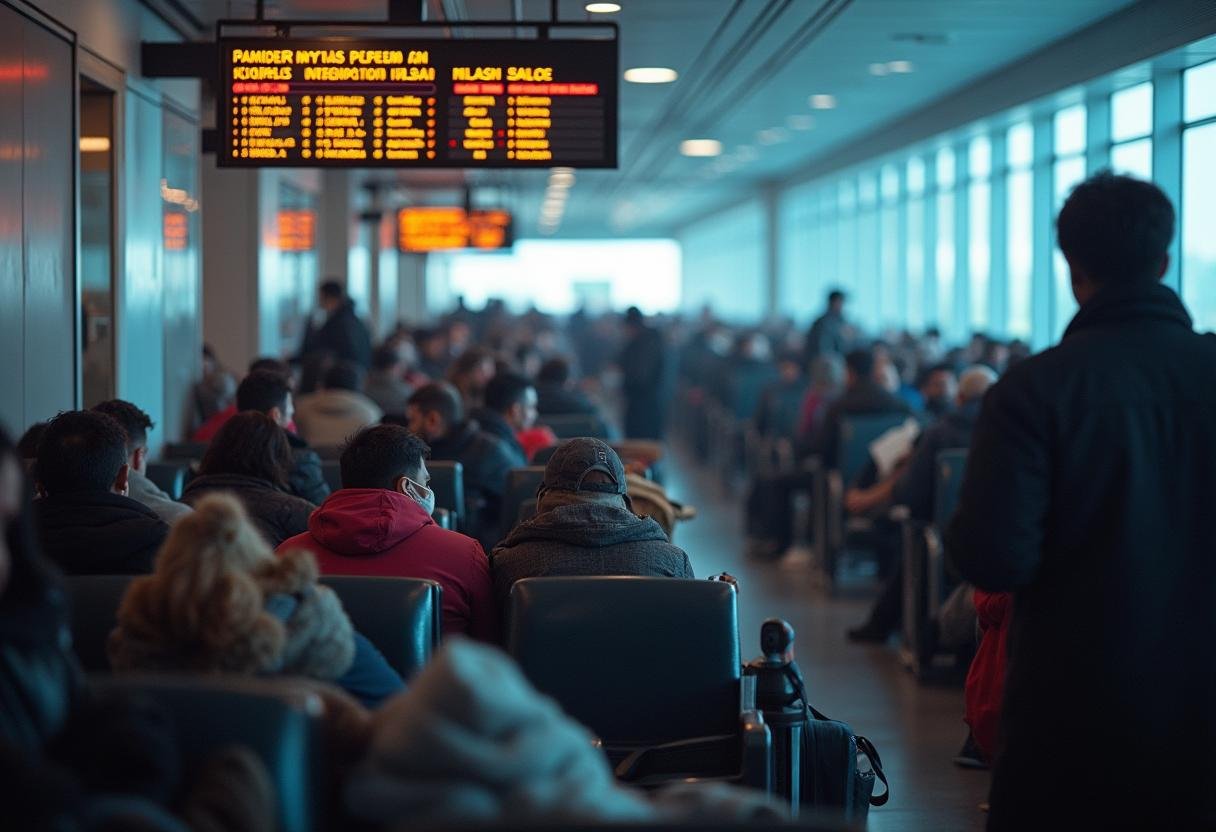Flight Buzz
Alaska Airlines unveils new plane livery and Seattle flights to London and Reykjavik

Alaska Airlines is expanding its international network by opening two new transatlantic routes from Seattle-Tacoma International Airport to London Heathrow Airport and Reykjavik, Iceland. Flights are scheduled to begin in spring 2026, marking a significant step in the airline’s strategy to become a global carrier.
The daily flight to London Heathrow Airport will be operated year-round on Alaska Airlines’ new Boeing 787-9 Dreamliner, which offers premium class amenities and 34 lie-flat suites in Business Class. The new seasonal route to Reykjavik will be operated daily during the summer months on Boeing 737-8 MAX aircraft.
“With these bold moves, we are accelerating our vision to connect our guests to the world. We are seizing this moment to redefine the international experience and level up. And we’re doing it with the same relentless focus on safety, care and performance that’s always defined us. I’m so proud of how our people continue to step up and deliver as we push ahead on these initiatives, with even more to come,” said Ben Minicucci, Alaska Airlines CEO.
The route launch coincides with the rollout of Alaska’s new global livery, which makes its debut only on the airline’s growing fleet of 787 Dreamliners. Inspired by the energy and spirit of the aurora borealis, the new design incorporates broad horizontal stripes of rich emerald green and deep midnight blue along the fuselage – an homage to Alaska’s natural environment and outstanding heritage, and a contemporary tribute to the iconic liveries from the 1970s and 1980s that link the airline’s past with its future. The aura’s flowing lines, visible in current premium cabins and main livery, give the design lightness, movement, and fluidity.
“Our new 787 exterior embodies Alaska’s transition to a global airline with beauty, grace and a nod to our heritage. As we significantly expand to new destinations around the globe, we’re eager for more and more travelers to recognize our new livery as being Alaska Airlines and appreciate the outstanding service we’ve long been known for,” commented Andrew Harrison, Alaska Airlines Chief Commercial Officer.
The carrier currently operates four 787-9s and plans to add up to 17 more aircraft by the end of the decade. A new pilot base in Seattle will support long-haul operations such as previously announced routes to Tokyo-Narita (January 2026), Rome (spring 2026), and a new nonstop service to Seoul-Incheon scheduled to launch on 12 September this year.
These steps will allow Alaska to compete more effectively in key transatlantic markets, as London remains the busiest international destination from Seattle, with more than 400 passengers flying between the two cities each day for both business and leisure, and Reykjavik is a bucket-list destination for adventure and outdoor lovers, also serving as a gateway to mainland Europe.
By 2030, Alaska aims to serve at least 12 international destinations from Seattle. The airline will also leverage partnerships with British Airways and American Airlines to provide broader connectivity through Oneworld Alliance networks.
Tickets for both routes are expected to go on sale later this fall. The London service will operate year-round, while flights to Reykjavik will run from mid-May through early September.
As Alaska Airlines looks to broaden its international presence, the new offerings serve part of a larger commitment to better customer service, premium travel experiences, and expanded global access from the West Coast.
Flight Buzz
Booking Flights At 2 AM Will Save You Big Time

At some point, you’ve probably heard that booking flights at 2 a.m. is the secret to finding the cheapest deals. It’s a popular tip that has been circulating by word of mouth and social media for years. But is this advice true, or is it just another believable travel myth? It actually falls somewhere in the middle.
Airfare pricing isn’t random. It’s determined by artificial intelligence (AI) and machine learning systems that adjust prices in real time based on several factors that can change at any moment. While searching in the middle of the night doesn’t guarantee you’ll find the lowest fare, there are a few reasons why late-night searches can work in your favor.
Here are the real reasons why flight prices change, and how night owls might get lucky with a cheap fare if they know what to look for.
Late-Night Flight Searches May Beat The Algorithm
Airlines use dynamic pricing, a strategy that changes ticket prices in real time based on things like demand, competition, and seat availability. These factors can shift quickly, which is why flight prices often change throughout the day.
According to a report from NBC News, because of this strategy, the number of people actively searching for flights can influence pricing. When fewer people are browsing a specific route, prices may dip due to lower demand. On the other hand, if a large number of users are searching for the same destination, even if they’re not booking, it can trigger an increase in fare prices, simply because the system registers a surge in interest.
That’s why booking in the middle of the night, like at 2 a.m., can work in a traveler’s favor. With fewer people online and most corporate bookings happening during business hours, there’s less competition for fares and less activity stimulating the pricing algorithm.
Late-night searches for flights can also line up with airline flash sales – many of which drop just before or after midnight.
Flash Sales Tend To Launch At Midnight
A man and woman booking flight tickets on a laptop.
Many travelers have probably come across a website late at night that’s down for maintenance. This is because companies often schedule updates during off-peak hours, which would include 2 a.m. Airlines follow the same logic when launching flash sales. These limited-time deals offer steep discounts on select routes, are designed to create urgency, and often go live right around midnight.
By rolling out deals when internet traffic is low, airlines can prevent their sites from slowing down or crashing. Midnight is often the start of a new pricing day in many airline systems, which is when scheduled fare updates or flash sales may go into effect. But because airlines operate across multiple time zones, what counts as “midnight” varies. In other words, these updates might appear at different times depending on where you’re searching from.
This is why timing is important in this case. If a sale launches at midnight and only a handful of discounted seats are available, you may still have a chance to grab one by searching shortly after. To improve the odds of booking a flash deal, travelers should find out the airline’s local time zone, set fare alerts in advance, and book directly through the airline’s website instead of on third-party platforms.
Third-Party Booking Sites Can Help Travelers Snag Leftover Deals
The Skyscanner app on a smartphone.
Online travel agencies (OTAs) like Booking.com, Expedia, Google Flights, and Skyscanner are great for comparing fares across multiple airlines, but they don’t always have the most up-to-date prices listed. If you’ve ever clicked on a great deal only to see a higher price at checkout, you’ve experienced this delay in real time.
OTAs use Application Programming Interfaces (APIs) to pull pricing data directly from the airlines. However, depending on the software and how often the data refreshes, the updates don’t always sync right away. As a result, travelers might see a lower fare that’s already changed on the airline’s website.
These leftover fares usually don’t last long, but travelers may be able to book the deal before the system catches up. However, it’s important to keep in mind that the fare might disappear at checkout if it’s already expired.
Does the Day You Book Flights Still Matter?
calendar with pins on certain days
For years, travelers have been told to book flights on a Tuesday to get the best deals. But according to a TikTok video from @cnbcselect, the day you book your flight doesn’t really matter anymore. Because of dynamic pricing and real-time fare updates, cheap tickets can appear any day of the week.
What does matter is the day of the actual flight. Mondays and Fridays tend to be more expensive since business travelers prefer these days. On the other hand, flights that leave on Tuesdays, Wednesdays, and Thursdays are usually cheaper because demand is lower. The time of day a flight leaves also affects the price. Early morning flights are often less expensive because most people don’t want to wake up early to catch them.
Finally, travelers should follow the “21-day rule,” which says that three weeks before departure is the latest anyone should book a flight to minimize unexpected price increases. After the 21-day mark, airlines often raise fares as travel dates get closer.
While there’s no longer a “best day” to purchase a flight ticket, the idea of booking it at 2 a.m. does hold some truth. Booking flights can seem like a guessing game, but understanding how the system works can give you an advantage while searching for the best deal.
Flight Buzz
Saudi Arabia Sets Revolutionary Aviation Benchmarks During Hajj 2025, Efficiently Handling Over 140,000 Flights in a Brilliant Display of Operational Mastery

Published on
August 9, 2025 |
Saudi Arabia has achieved an extraordinary feat during Hajj 2025, shattering global air traffic records by managing over 140,000 flights, marking a groundbreaking 8% increase from the previous year. The Kingdom orchestrated a seamless flow of air traffic, effectively handling a monumental number of domestic and international flights, underscoring its dominance in global aviation. This remarkable achievement highlights Saudi Arabia’s unmatched precision and operational excellence in facilitating one of the largest annual religious events in the world. With a record 2,338 air movements in a single day, the Kingdom has set new standards in air traffic management, solidifying its leadership as a vital global aviation hub. Through strategic planning and cutting-edge technology, Saudi Arabia has demonstrated its unwavering commitment to ensuring a safe, smooth, and efficient pilgrimage experience for millions of Muslims worldwide.
Saudi Arabia achieved a historic milestone during the 2025 Hajj season, successfully managing over 140,000 air movements, marking an 8% increase compared to the previous year. This remarkable feat highlights the Kingdom’s commitment to streamlining logistics and enhancing air traffic operations, ensuring a smooth pilgrimage experience for millions of Muslims worldwide.
A Surge in Air Traffic
The 2025 Hajj season (Hajj 1446 AH) witnessed record-breaking air traffic, with more than 140,000 flights handled by Saudi Arabia’s airspace. These flights consisted of both domestic and international air movements, underlining the Kingdom’s essential role in facilitating the pilgrimage. The Saudi Air Navigation Services (SANS) coordinated air traffic for 213 airlines, further reinforcing Saudi Arabia’s global connectivity and importance as a key aviation hub for religious tourism.
Key Highlights of Air Traffic Operations
- Single-Day Peak: On Dhu Al-Hijjah 2, 1446 AH, Saudi Arabia achieved a new record for air traffic, with 2,338 aircraft movements in a single day. This marked a 4% increase over the same day in 2024, showcasing the Kingdom’s growing air traffic capacity.
- Arrival and Departure Phases:
- Arrival Phase: During the period from Dhu Al-Qidah 1 to Dhu Al-Hijjah 8, there were 74,902 air movements, representing a 15% increase over the previous year. This reflects a significant surge in the number of incoming flights as millions of pilgrims arrived in the Kingdom for Hajj.
- Departure Phase: From Dhu Al-Hijjah 23 to Muharram 15, Saudi Arabia recorded 66,072 air movements during the departure phase, showing a 2% increase compared to 2024.
These figures demonstrate the Kingdom’s ability to handle substantial air traffic volume, with arrivals seeing a particularly impressive increase in comparison to the previous year.
Advanced Operational Strategies and Technology
The success of Saudi Arabia’s air traffic management during Hajj 2025 can be attributed to advanced technological infrastructure and highly skilled personnel. The Saudi Air Navigation Services company (SANS) deployed sophisticated air traffic management systems, ensuring seamless operations despite the high volume of air movements. This technological infrastructure was paired with highly trained air traffic controllers, engineers, and maintenance teams, all working together to ensure the safety and efficiency of each flight.
Furthermore, Saudi Arabia’s airspace management allowed for smooth and coordinated air traffic flows across all major airports in the Kingdom, facilitating the swift and safe arrival and departure of millions of pilgrims from various parts of the globe.
Saudi Arabia’s Growing Role in Global Aviation
The record air traffic numbers during the Hajj season also reflect Saudi Arabia’s growing role in global aviation. By coordinating with 213 international airlines, the Kingdom further established itself as a central hub for international air travel. This broad international participation underscores Saudi Arabia’s increasing influence in global aviation, making it a key gateway for pilgrims from around the world.
As the Kingdom’s aviation infrastructure continues to improve, Saudi Arabia’s connectivity to global airlines grows stronger, expanding its reach as a leading air transport hub. The Kingdom’s strategic location between continents also plays a pivotal role in facilitating smooth air traffic operations, benefiting both religious pilgrims and international travelers.
Ensuring a Seamless Pilgrimage Experience
At its core, the success of Saudi Arabia’s air traffic management during Hajj 2025 is driven by the Kingdom’s commitment to providing a safe, smooth, and efficient pilgrimage experience for Muslims worldwide. The 140,000 flights, including the record-breaking 2,338 aircraft movements in a single day, demonstrate Saudi Arabia’s preparedness and capacity to handle large-scale religious events.
The operational excellence displayed during the Hajj season not only benefits the logistics of the pilgrimage but also contributes to the spiritual journey of millions. The efficient air traffic flow ensures that pilgrims can focus on their religious duties without concerns about travel-related disruptions.
Looking Ahead: Preparing for Future Hajj Seasons
The remarkable success of Hajj 2025 sets a new benchmark for the Kingdom in terms of air traffic management. As Saudi Arabia continues to modernize its air navigation systems and infrastructure, it is poised to handle even greater volumes of traffic in future seasons.
The strategic role of Saudi Arabia in global air traffic will continue to grow as the Kingdom enhances its international partnerships with airlines and expands its technological capabilities. With future Hajj seasons expected to draw even more pilgrims, Saudi Arabia’s ability to manage air traffic efficiently will be crucial to ensuring the safety and success of the pilgrimage.
In conclusion, Saudi Arabia’s achievement in handling over 140,000 flights during Hajj 2025 not only showcases its operational excellence but also underscores the Kingdom’s importance as a global hub for air travel. The continued development of Saudi Arabia’s aviation infrastructure will only further cement its position as a leader in religious tourism and international air connectivity.
Flight Buzz
More Than Three Hundred Flights Delayed At Delhi Airport Due To Severe Weather

Published on
August 9, 2025 |
New Delhi had to deal with a major disruption to travel as Indira Gandhi International Airport had more than 300 flights delayed due to the bad weather. The national capital region experienced heavy rain along with thunderstorms, lightning, as well as strong winds, which caused a big impact on both ground and aerial transport. With the India Meteorological Department (IMD) issuing weather warnings, the storm caused a lot of trouble for both locals and tourists.
Arriving and departing passengers flying to and from Delhi Airport had to deal with long delays of their flights as a result of bad weather conditions. Although the airport tried to operate normally, the bad weather made it impossible to maintain normal schedules, which led to cascading delays throughout the day.
Widespread Disruption Due to Extreme Weather
The heavy rain started late at night and then continued the next morning, with thunderstorms along with lightning adding to the chaos. Flight tracking services like Flightradar24 reported hundreds of flights being delayed due to rain, strong winds, and the combination of unstable weather.
As the weather conditions deteriorated, the IMD issued a rain alert for the city, forecasting moderate rain, thunderstorms, and winds between 30-40 km/h. The department also issued an alert concerning critical Safety guidelines, recommending people skip outdoor activities during the storm. The IMD, as is the norm, posted reminders telling people to be careful while driving, secure loose articles lying around on balconies and rooftops, and refrain from standing under trees during lightning due to the risk of a bolt falling during the storm surge.
The weather-related events, although not heavily impacting the Delhi Airport, at the very least resulted in several flights not being able to take off, land, or be on schedule. Weather-related disruptions cascaded in a domino effect throughout the day, forcing wait times for most travelers.
Effect on Surface Transportation and Day-to-Day Activities
Apart from the air travel disruption, the storm-affected areas extended well beyond the airport. Overnight rainfall in the Delhi-NCR region, and Panchkuian Marg, Mathura Road, and Connaught Place, resulted in waterlogging. The waterlogged areas brought about terrible traffic congestion, and added to the already overburdened delays on the arterial highways, and resulted in delays for a plethora of travelers looking to navigate the city.
Locals took action by issuing home travel advisories, asking people to stay home if possible, and to minimize travel. For people who needed to leave the house, traveling through the flooded streets was difficult. Roads being flooded with rain brought the usual city noise to a standstill, which added to the agony of commuters.
Airlines Respond with Travel Advisories
Due to the weather conditions, some airlines issued advisories for passengers to help them navigate through the disruption. One of the major airlines operating out of Delhi, IndiGo, and SpiceJet, informed passengers through their social media accounts about the delays. Both airlines advised travelers to monitor the flights and adjust their travel plans as conditions worsened.
Air India was also warning travelers with a message saying the heavy rain may affect flight operations to and from Delhi. Air India was also recommending passengers to modify their plans early, as the flights and the traffic were expected to create some congestion. In spite of the disruption, the airline was focused on operational and safety efficiency for passengers during the storm.
Such proactive communication helped passengers manage their travel plans because they did not have to show up at the airport and deal with unnecessary waiting. Many travelers, for the most part, adapted to the changes, even if it meant arriving much earlier than they had originally planned.
The Situation at the Delhi Airport
Due to the extensive delays caused by the weather, the Delhi Airport continues to remain operational. To the general public, “everything was normal.” As for the airport, “normal flight operations” meant that a substantial number of flights were still being delayed. Staff were doing their utmost to streamline the essential security and boarding procedures, but the large number of delayed flights was a significant bottleneck.
In a press release, the airport’s official representative acknowledged that flight operations were continuing but advised passengers to coordinate with their respective airlines for the most current flight schedules. Alongside that, the representative added that the airport was actively trying to work with the airline’s weather-related restrictions to limit the consequences of the bad weather on flights that were meant to take off.
Even though flights were still operating, passengers were experiencing severe disruptions to their journeys due to the weather. The delays to flights arriving and departing were resulting in very long lines at the check-in counters, and customers were often left guessing as to whether their flights were going to be further delayed or canceled altogether.
IMD Issues Red Alert for Delhi
The IMD was continuously monitoring the situation and issued a red alert, meaning moderate to heavy rain was still expected for the rest of the weekend. The IMD advised the public to remain vigilant and stay out of the band of additional weather disruptions that were expected.
Local Weather authorities also warned and restricted of the creeping flooding, especially in the low-lying areas, advising people to cease all non-essential movement. Delhi has a long history of heavy rain towards the end of the tapering monsoon season, but the sheer power of this storm was astonishing, especially as it showcased the unpredictability of the region’s weather.
Conclusion
The memories from August 9, 2025, still linger, serving as a pertinent reminder of how disruptive weather can be to both air and ground travel. The storm single-handedly brought the capital to a standstill, with over 300 flights being delayed at the Delhi Airport, and the heavy rains disrupting daily activities. Airlines, the IMD, and local authorities collaborated to manage the situation, and while their efforts to keep the public informed were noted, the disruption itself was unavoidable.
As the weekend approaches, both travelers and residents alike are being warned to stay vigilant and keep track of weather updates. For travelers passing through Delhi, the storm was certainly a reminder of how critical planning, preemptive measures, and being flexible can be when dealing with weather-related events.
(Source: India Meteorological Department, Delhi Airport, Flightradar24, IANS)
-

 Brand Stories3 weeks ago
Brand Stories3 weeks agoBloom Hotels: A Modern Vision of Hospitality Redefining Travel
-

 Brand Stories2 weeks ago
Brand Stories2 weeks agoCheQin.ai sets a new standard for hotel booking with its AI capabilities: empowering travellers to bargain, choose the best, and book with clarity.
-

 Destinations & Things To Do3 weeks ago
Destinations & Things To Do3 weeks agoUntouched Destinations: Stunning Hidden Gems You Must Visit
-

 Destinations & Things To Do2 weeks ago
Destinations & Things To Do2 weeks agoThis Hidden Beach in India Glows at Night-But Only in One Secret Season
-

 AI in Travel3 weeks ago
AI in Travel3 weeks agoAI Travel Revolution: Must-Have Guide to the Best Experience
-

 Brand Stories1 month ago
Brand Stories1 month agoVoice AI Startup ElevenLabs Plans to Add Hubs Around the World
-

 Brand Stories4 weeks ago
Brand Stories4 weeks agoHow Elon Musk’s rogue Grok chatbot became a cautionary AI tale
-

 Brand Stories2 weeks ago
Brand Stories2 weeks agoContactless Hospitality: Why Remote Management Technology Is Key to Seamless Guest Experiences
-

 Asia Travel Pulse1 month ago
Asia Travel Pulse1 month agoLooking For Adventure In Asia? Here Are 7 Epic Destinations You Need To Experience At Least Once – Zee News
-

 AI in Travel1 month ago
AI in Travel1 month ago‘Will AI take my job?’ A trip to a Beijing fortune-telling bar to see what lies ahead | China













You must be logged in to post a comment Login